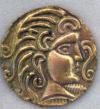Strange Hexagon Storm On Saturn Rages

First seen in 2008, these images from NASA’s Cassini spacecraft reveal a giant cyclone at Saturn’s north pole, and show that a similarly monstrous cyclone churning at Saturn’s south pole is powered by Earth-like storm patterns and is still raging four years later.
In 2008, the cyclone at Saturn’s north pole was only visible in the near-infrared wavelengths because the north pole is in winter, thus in darkness to visible-light cameras. At these wavelengths, about seven times greater than light seen by the human eye, the clouds deep inside Saturn’s atmosphere are seen in silhouette against the background glow of Saturn’s internal heat.
“These are truly massive cyclones, hundreds of times stronger than the most giant hurricanes on Earth,” said Kevin Baines, Cassini scientist in 2008 on the visual and infrared mapping spectrometer at NASA’s Jet Propulsion Laboratory, Pasadena, Calif. “Dozens of puffy, convectively formed cumulus clouds swirl around both poles, betraying the presence of giant thunderstorms lurking beneath. Thunderstorms are the likely engine for these giant weather systems,” said Baines.
The entire north pole of Saturn is now mapped in detail in infrared, with features as small as 120 kilometers (75 miles) visible in the images. Time-lapse movies of the clouds circling the north pole show the whirlpool-like cyclone there is rotating at 530 kilometers per hour (325 miles per hour), more than twice as fast as the highest winds measured in cyclonic features on Earth. This cyclone is surrounded by an odd, honeycombed-shaped hexagon, which itself does not seem to move while the clouds within it whip around at high speeds, also greater than 500 kilometers per hour (300 miles per hour). Oddly, neither the fast-moving clouds inside the hexagon nor this new cyclone seem to disrupt the six-sided hexagon.
New Cassini imagery of Saturn’s south pole shows complementary aspects of the region through the eyes of two different instruments. Near-infrared images from the visual and infrared mapping spectrometer instrument show the whole region is pockmarked with storms, while the imaging cameras show close-up details.
› Full image and caption
NASA’s Cassini spacecraft has been traveling the Saturnian system in a set of inclined, or tilted, orbits that give mission scientists a vertigo-inducing view of Saturn’s polar regions. This perspective has yielded images of roiling storm clouds and a swirling vortex at the center of Saturn’s famed north polar hexagon.
These phenomena mimic what Cassini found at Saturn’s south pole a number of years ago. Cassini has also seen storms circling Saturn’s north pole in the past, but only in infrared wavelengths because the north pole was in darkness. (See http://www.jpl.nasa.gov/news/news.php?release=2008-192 .) But, with the change of the Saturnian seasons, the sun has begun to creep over the planet’s north pole.
This near-infrared movie of Saturn’s north pole shows a giant cyclone, encircled by a hexagon feature. The movie was created from several images, taken by the visual and infrared mapping spectrometer onboard the Cassini spacecraft.
The hexagon itself is populated by fast-moving clouds which reach speeds of over 530 kilometers per hour (300 miles per hour). The discrete, circular and oblong clouds dotting the image are likely convective upwelling originating deep inside the planet, which help power the cyclones. The movie shows clouds throughout the atmosphere, down to as deep as 125 kilometers (78 miles) below the haze. Many of the features seen are thought to be deep-level clouds of ammonia-hydrosulfide, which rise to higher altitudes in convective updrafts.
This particular set of raw, unprocessed images was taken on Nov. 27, 2012, from a distance of about 250,000 miles (400,000 kilometers) from Saturn.
More raw images are available at http://saturn.jpl.nasa.gov/photos/raw/index.cfm. The Cassini-Huygens mission is a cooperative project of NASA, the European Space Agency and the Italian Space Agency. JPL, a division of the California Institute of Technology in Pasadena, manages the Cassini-Huygens mission for NASA’s Science Mission Directorate, Washington. The Cassini orbiter and its two onboard cameras were designed, developed and assembled at JPL. The imaging team is based at the Space Science Institute in Boulder, Colo.
Baltic Sea UFO Released On Video By Captain Of Ship, Nov 27, 2012, Government Cover-Up Claimed
Giant UFO Seen As It Leaves Earth’s Atmosphere By ISS Live Cam
Lizard People In Portugal, An Invasive Mind Scan Carried Out By Reptilians
New Type Of Matter Created By Large Hadron Collider Say Astounded Scientists
Vortex At South Pole Of Titan Reverses Unexpectedly! Why? See The Movie
Record-Setting X-Ray Jet Discovered
Archaeologists Discover Shipwrecks, Ancient Harbor On Coast Of Israel
Women 16–49 At Risk Of Multiple Pollutants
Extremely Scary Ghost Elevator Prank in Brazil
Human Mutilations By Aliens (Warning Graphic Photos)
Goat Man Sightings In Kentucky, Texas, Maryland
Time-Lapse Map of Every Nuclear Explosion Since 1945 – by Isao Hashimoto
Gravitational Shockwave Weapons: Patented Handgun That Can Destroy Anything
Brown Dwarfs May Grow Rocky Planets, Earth-Scale Planets May Be More Common Than Expected
Biggest Blast In The Universe, It’s Off The Charts Say Scientists, Dwarfs Energy Of Entire Milky Way
The Beginning of Everything: A New Paradigm Shift For The Infant Universe
Ice Sheet Loss At Both Poles Increasing, Major Study Finds
New Evidence For Water Ice On Mercury
Net-Zero Home Could Eliminate Energy Bills
The Earth As Never Seen Before: First-Ever Hyperspectral Images
Oceanic Crust Breakthrough: Solving A Magma Mystery
Human Brain, Universe And Internet Grow In Similar Ways Say Scientists
Strange Hexagon Storm On Saturn Rages
Bioengineered Marine Algae Expands Environments Where Biofuels Can Be Produced
Two Suns Reported On Russian News
NIST Experiments Challenge Fundamental Understanding Of Electromagnetism
Archaeologists Discover Shipwrecks, Ancient Harbor On Coast Of Israel
Anyone can join.
Anyone can contribute.
Anyone can become informed about their world.
"United We Stand" Click Here To Create Your Personal Citizen Journalist Account Today, Be Sure To Invite Your Friends.
Before It’s News® is a community of individuals who report on what’s going on around them, from all around the world. Anyone can join. Anyone can contribute. Anyone can become informed about their world. "United We Stand" Click Here To Create Your Personal Citizen Journalist Account Today, Be Sure To Invite Your Friends.
LION'S MANE PRODUCT
Try Our Lion’s Mane WHOLE MIND Nootropic Blend 60 Capsules
Mushrooms are having a moment. One fabulous fungus in particular, lion’s mane, may help improve memory, depression and anxiety symptoms. They are also an excellent source of nutrients that show promise as a therapy for dementia, and other neurodegenerative diseases. If you’re living with anxiety or depression, you may be curious about all the therapy options out there — including the natural ones.Our Lion’s Mane WHOLE MIND Nootropic Blend has been formulated to utilize the potency of Lion’s mane but also include the benefits of four other Highly Beneficial Mushrooms. Synergistically, they work together to Build your health through improving cognitive function and immunity regardless of your age. Our Nootropic not only improves your Cognitive Function and Activates your Immune System, but it benefits growth of Essential Gut Flora, further enhancing your Vitality.
Our Formula includes: Lion’s Mane Mushrooms which Increase Brain Power through nerve growth, lessen anxiety, reduce depression, and improve concentration. Its an excellent adaptogen, promotes sleep and improves immunity. Shiitake Mushrooms which Fight cancer cells and infectious disease, boost the immune system, promotes brain function, and serves as a source of B vitamins. Maitake Mushrooms which regulate blood sugar levels of diabetics, reduce hypertension and boosts the immune system. Reishi Mushrooms which Fight inflammation, liver disease, fatigue, tumor growth and cancer. They Improve skin disorders and soothes digestive problems, stomach ulcers and leaky gut syndrome. Chaga Mushrooms which have anti-aging effects, boost immune function, improve stamina and athletic performance, even act as a natural aphrodisiac, fighting diabetes and improving liver function. Try Our Lion’s Mane WHOLE MIND Nootropic Blend 60 Capsules Today. Be 100% Satisfied or Receive a Full Money Back Guarantee. Order Yours Today by Following This Link.






